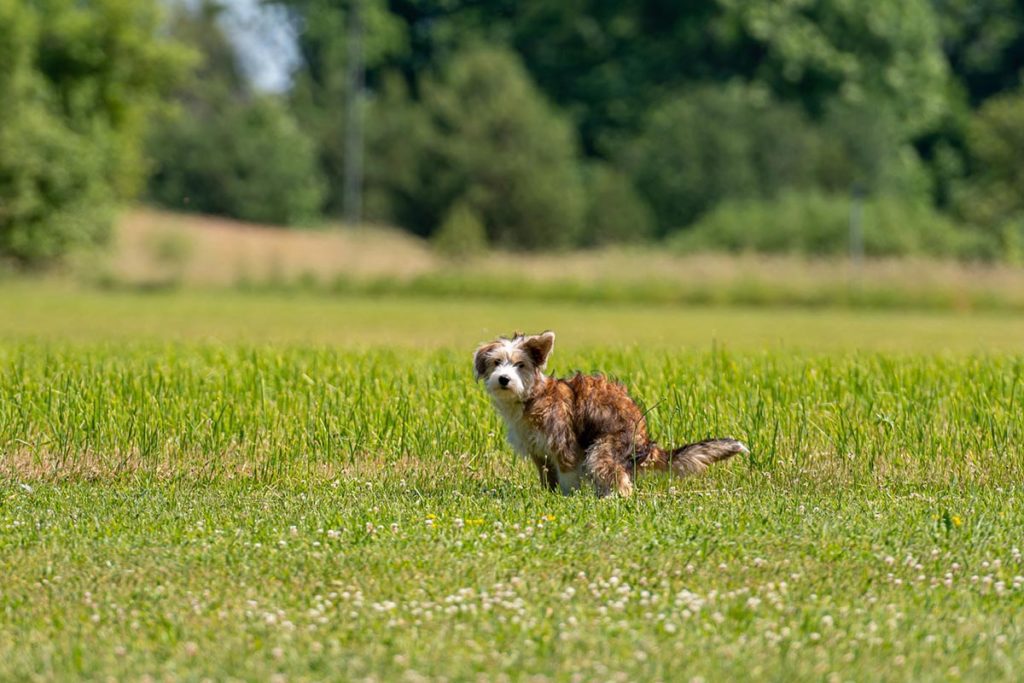What’s The Scoop on Poop in St. Paul, MN?
As veterinarians, poop is part of our daily work life (not too many people can have this honor). Questions about poo are amongst the most frequent ones we get. Although this topic is a bit gross to think about, poop color can give us a lot of information. In this article we will explore the many colors (a poop rainbow) and what it could mean for your pup’s health.

Chocolate Brown:
This is the color of normal stool which indicates proper gastrointestinal health and digestion.
Green:
If your dog’s poop is mostly brown with scattered chunks of green, it is most likely that they have been eating grass. Some dogs do this because they think it tastes good or maybe they are a bit bored. Rapidly eating grass followed by immediate vomiting may mean that your pet was nauseated. Dogs that eat to make themselves vomit usually swallow grass as quickly as possible, barely even chewing it. It is believed that the long, unchewed pieces of grass tickle their throats to stimulate vomiting.
If your pup’s poop suddenly turns green, you should contact your veterinarian right away as this could be a sign of a gallbladder issue or infection.
Yellow or Orange:
A sudden occurrence of yellow poop could mean gastrointestinal upset. Diarrhea often accompanies or soon follows.
Yellow or orange-tinged stool can also occur with liver disease, which can be serious.
Any time your dog’s poop is yellow or orange, it’s best to contact your veterinarian.
Red:
Red is an indicator of blood in the stool. The possible causes range from mild to extremely serious. Please contact your veterinarian any time you notice blood in the stool.
Gastrointestinal upset can cause diarrhea and subsequent straining to defecate. Streaks of blood and/or mucus may be seen. The frank (red) color is an indication that the blood is likely coming from the colon or the small capillaries in the anus/rectum. Also, make sure to check your dog for any potential cuts. Anal gland issues and internal parasites can be potential causes, too.
Diarrhea that looks like pure red blood and gelatinous is cause for concern. Veterinarians often describe this as raspberry jam consistency. This is often linked to a potentially life threatening disease called Hemorrhagic Gastroenteritis (HGE). This is a medical emergency and veterinary care should be sought immediately as this dehydrates them at a rapid rate.
 Black and Tarry or Black Coffee Ground Appearance:
Black and Tarry or Black Coffee Ground Appearance:
This can be an indication of a bleed in the upper gastrointestinal tract (stomach, small intestines). The most common causes are GI ulcers, damage to the lining of the stomach or small intestines, and less likely internal parasites. The black color indicates that the bleed is in the upper GI tract and goes through the digestive process which turns it black. This is a medical emergency and veterinary care should be sought immediately.
Gray and Greasy:
Gray poop is normal if it has been exposed to the elements for long periods of time and hardens. This is likely just the stool’s normal aging process.
However, if your pup’s poop is gray when they pass it, it can be a sign of digestive complications, often as result of improper pancreas function. Grey stool is never normal, so please contact your veterinarian.
White Spots That Look Like Grains of Rice or Spaghetti Noodles:
Be on the lookout for internal parasites (yes, worms). Tapeworm segments look like grains of white rice, while roundworms are long like spaghetti noodles. It is important to bring in a sample of your dog’s stool to the veterinarian for evaluation and treatment.
Final Thoughts:
We often think of poop as just stinky waste that needs to be disposed of in plastic bags or picked up from the lawn. Hopefully now, you will also view it as an investigative tool into your pet’s health. If you have questions regarding this topic or any other concerns, please contact St. Paul Pet Hospital at (651) 789-6275 or stpaulpet@gmail.com.
Resources: https://chihuacorner.com/dog-poop-color-chart-what-it-shows-about-your-chis-health/


 Black and Tarry or Black Coffee Ground Appearance:
Black and Tarry or Black Coffee Ground Appearance: